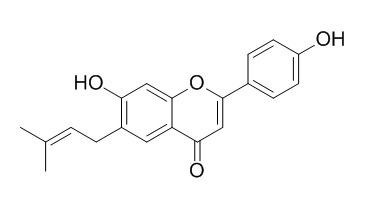Licoflavone A
Reference standards.
Inquire / Order:
manager@chemfaces.com
Technical Inquiries:
service@chemfaces.com
Tel:
+86-27-84237783
Fax:
+86-27-84254680
Address:
1 Building, No. 83, CheCheng Rd., Wuhan Economic and Technological Development Zone, Wuhan, Hubei 430056, PRC
Providing storage is as stated on the product vial and the vial is kept tightly sealed, the product can be stored for up to
24 months(2-8C).
Wherever possible, you should prepare and use solutions on the same day. However, if you need to make up stock solutions in advance, we recommend that you store the solution as aliquots in tightly sealed vials at -20C. Generally, these will be useable for up to two weeks. Before use, and prior to opening the vial we recommend that you allow your product to equilibrate to room temperature for at least 1 hour.
Need more advice on solubility, usage and handling? Please email to: service@chemfaces.com
The packaging of the product may have turned upside down during transportation, resulting in the natural compounds adhering to the neck or cap of the vial. take the vial out of its packaging and gently shake to let the compounds fall to the bottom of the vial. for liquid products, centrifuge at 200-500 RPM to gather the liquid at the bottom of the vial. try to avoid loss or contamination during handling.
BMC Complement Altern Med.2018, 18(1):221
Nat Commun.2023, 14(1):5075.
J Control Release.2024, 375:300-315.
Sichuan Agricultural University2023, 4630743.
J of Health Science and Alternative Medicine2019, 1(1)
Mol Pharm.2018, 15(8):3285-3296
Exp Ther Med.2019, 18(6):4388-4396
Molecules.2019, 24(22):E4022
Chem Biol Interact.2019, 298:1-7
Phytomedicine.2019, 55:229-237
Related and Featured Products
Bioorg Med Chem Lett. 2010 Sep 15;20(18):5398-401.
Prenylflavonoids from Glycyrrhiza uralensis and their protein tyrosine phosphatase-1B inhibitory activities[Pubmed:
20724155]
METHODS AND RESULTS:
Two new 2-arylbenzofurans, glycybenzofuran (1) and cyclolicocoumarone (2), together with 10 known flavonoids including licocoumarone (3), glycyrrhisoflavone (4), glisoflavone (5), cycloglycyrrhisoflavone (6), isoliquiritigenin (7), Licoflavone A (8), apigenin (9), isokaempferide (10), glycycoumarin (11), and isoglycycoumarin (12), were isolated from the roots of Glycyrrhiza uralensis and their structures were determined by extensive spectroscopic analyses. Compounds 1 and 5 showed significant protein tyrosine phosphatase-1B (PTP1B) inhibitory activity in vitro with the IC50 values of 25.5 and 27.9 μM, respectively.
CONCLUSIONS:
The structure–activity relationship indicated that the presence of prenyl group and ortho-hydroxy group is important for exhibiting the activity. Kinetic analysis indicated that compound 1 inhibits PTP1B by a competitive mode, whereas compound 5 by a mixed mode.



